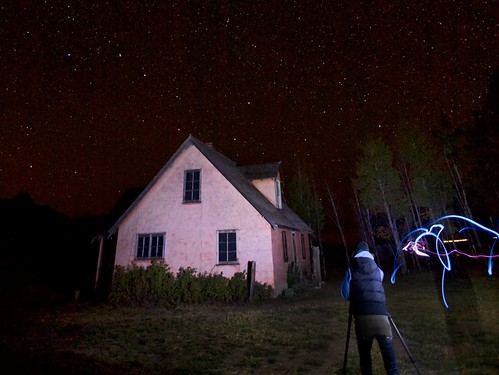
Photo by Scott Stulberg.
Guest Post for TWIP.
Even if you are not familiar with the term light painting, you’ve probably already experimented with it. Have you ever swirled your camera around the twinkling lights on your Christmas tree to create spirals, or shapes; or the initials of your name, or captured the twisting, turning trail of sweet glow sticks or a Poi spinner at some crazy full moon party in Thailand? Then you, my friend, are a light painter!
Light painting is a photographic technique where you physically ‘paint’ light into your camera frame during a long exposure, either by manipulating a light source like a flashlight, flash or by moving the camera around a light source.
During our star shoot at the Aperture Nature Photography Workshop, Scott Stulberg pointed out a beautiful Mormon barn and suggested that we light paint it.
Light paint a barn? Oh yes! The idea seemed crazy because all my previous experimentation with light painting had been on such a small scale, and the only light we had was a headlamp, but Scott was determined.
We set up in front of the barn and starting testing different settings. Because it was impossible to grab focus, I ran up close to the house and shon the headlamp on a window. Once Scott got his focus set, we got to the painting.
By cupping the headlamp with one hand, we were able to direct the light on the house and trees, carefully avoiding the foreground. It was a lot like actual painting. Starting with the roof of the house, you gracefully paint the shingles, then the sides, then the front, giving a little extra light to the windows and doors.
The trees were tricky. It took so much time to paint the house correctly that we always ran out of time to do the trees fully. We’d start at the bottoms of the trees and paint upwards, trying to hit the top and then swoop downwards. We tried for a while, but we just weren’t getting the light composition we wanted. The shot was just a little flat.
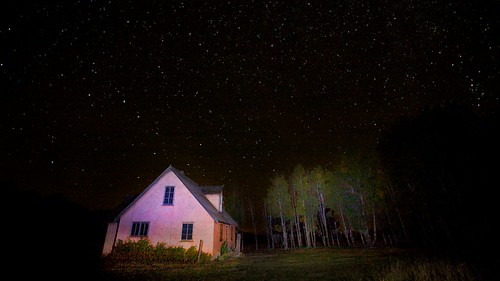
Canon 5D 16-35mm f/2.8 lens: 25s exposure, f/3.2, ISO 1250.
Martin suggested that we light up the barn using a short blast from a car’s headlights. So we moved a car about 200m away from the barn, angling the lights at the barn and the adjacent trees. Timing was a bit tricky, as the headlights could only be on for less than a second or they would blow out the shot like the photo below.
This is the view from the car. You can see the group setting up for the shot. I was the gal in charge of turning the lights off and on so I didn’t get a chance to grab this shot. But here’s Scotty’s shot. He had a little extra light from a passing car. That is why the foreground is lit. Pretty cool effect, don’t you think?
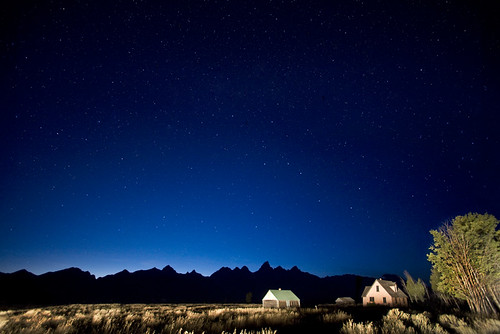
Photo by Scott Stulberg. Settings with 14mm: 20s Exposure, f/2.8, ISO 800.
After taking this shot we ran into Dave Black (a legendary light painter) and his team, who were about to start an epic 30 minute light painting project. See the results and how he did it on his website. They are truly remarkable.
Light painting is a really dynamic photographic technique that you can really get creative with. You don’t need boat loads of money to experiment, just a flashlight and some coloured gels will do to start with. Gels are quite expensive if you buy them off the roll. But if you are up for a little DIY, you can get a nifty lil book of sampler gels and filters from LEE Filters.
I bought this little pack for $2.99 at a local photography store. It had a great selection of gels big enough to fit on my flashes (Canon EX430 & EX580). If you can’t find them, try contacting LEE, they will usually send out the sampler pack for free. If you are in the UK, check out Flashgels.co.uk
If you want some inspiration and to see how far you can push light painting, check out this amazing collection of light paint art in Smashing Magazine, Strobist’s guides and tutorials to light painting with strobes, and the light painted group on flickr.


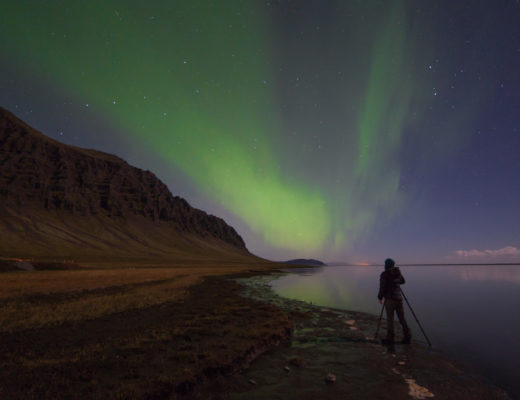
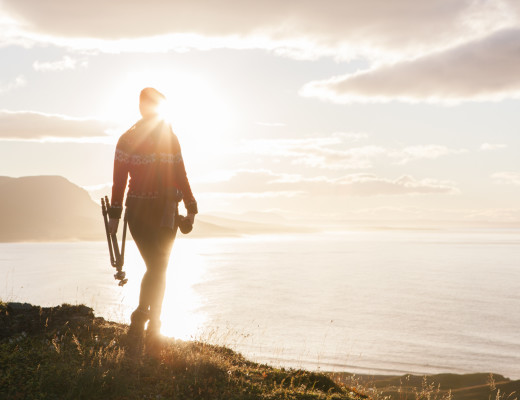

Tyler Ingram
October 29, 2008 at 6:55 AMI’ve done the light painting where you use a flash light and draw around a person or create a shape infront of the camera. I never though about actually painting light onto an object like you guys did with the tree and barn.
I’ll have to try that one day when i can stay up long enough for the dark to happen! lol
Thai girl
October 29, 2008 at 6:59 AMcool beans!
You’ve been to the full moon party in Thailand before? When you coming back? I’m gonna take you around.
Lis311
October 29, 2008 at 7:13 AMI haven’t gone all out with light painting, but there are a couple of photos I’m particularly proud of :-)
http://www.flickr.com/photos/lis311/544755749
http://www.flickr.com/photos/lis311/208051246
Masey
October 29, 2008 at 8:35 AMThis has always been one of my favourite examples of light painting.
http://moourl.com/htf51
Can’t wait to get into more of it myself this Winter…
Rob Trueman
October 29, 2008 at 11:42 AMClearly, I left before the good stuff! Wow, these images are great. Plus, you got to shoot with Dave Black – a true guru in photography. Plus, you were sick! You did well, Lisa! Very, very well.
Christopher Blunck
October 29, 2008 at 4:32 PMI’ve tried light painting a few times and failed miserably. One of the many challenges of light painting is that it requires either a very bright light to paint with if you’re going for exposures < 30 seconds or it requires you to purchase a “bulb” kit for your camera. Depending on your make and model the bulb can be pricey.
I didn’t want to plunk about $120 into a bulb for my camera knowing that a pair of PocketWizards would be more useful, and I didn’t want to drop the coin on a pair of those just to experiment with painting. As a result I went with the “what can I paint in 30 seconds”. Even with a Mag Lite with 4 D batteries standing about 30 feet away from some trees I couldn’t throw enough light onto the scene to make a difference.
Light Painting truly is an art but there are a lot of scientific fundamentals that need to be delicately balanced in order to create the experience you want. Hats off to anyone willing to try it out and to those that are so great at it. A good light painter can take some truly amazing shots.
Fred Hill
October 29, 2008 at 8:53 PMLight painting photos always draw me in. I love the look of them. I need to try it out some time and see how I do. I just need to have a good place to set-up my tripod and a strong flashlight.
Mark Cohen
November 4, 2008 at 4:02 AMMy absolute favourite light-pianting photo I’ve ever taken is this one
http://www.flickr.com/photos/rageman/1726418640/sizes/m/
When I learned about light painting my teacher showed us photos where the photographer (who’s name I forget of course) went inside a really old and dilapidated house and fired off his flash against the walls inside, making each window glow a different colour. That worked magically in the pics.